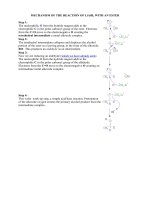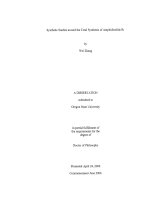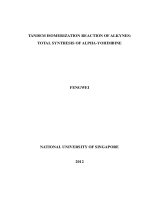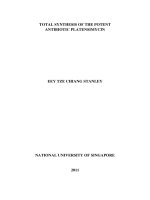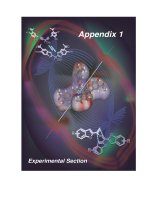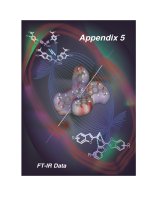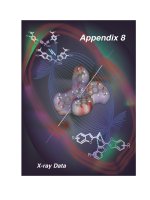Tandem isomerization reaction of alkyne total synthesis of alpha yohimbine
Bạn đang xem bản rút gọn của tài liệu. Xem và tải ngay bản đầy đủ của tài liệu tại đây (8.07 MB, 211 trang )
TANDEM ISOMERIZATION REACTION OF ALKYNES:
TOTAL SYNTHESIS OF ALPHA-YOHIMBINE
FENGWEI
NATIONAL UNIVERSITY OF SINGAPORE
2012
TANDEM ISOMERIZATION REACTION OF ALKYNES:
TOTAL SYNTHESIS OF ALPHA-YOHIMBINE
FENGWEI
2012
TANDEM ISOMERIZATION REACTIONS OF
ALKYNES: TOTAL SYNTHESIS OF
ALPHA-YOHIMBINE
FENG WEI
(BSc., Nankai University)
A THESIS SUBMITTED
FOR THE DEGREE OF DOCTOR OF PHILOSOPHY
DEPARTMENT OF CHEMISTRY
NATIONAL UNIVERSITY OF SINGAPORE
To my family
For their love, support, and encouragement
Acknowledgements
First and foremost, I would like to take this opportunity to thank my supervisor,
Associate Professor Tan Choon-Hong, for his guidance and encouragement
throughout my PhD research and study.
I would like to thank all my labmates for creating such a harmonious,
encouraging, and helpful working environment. My special thanks go to Mr. Liu
Hongjun for his pioneering work on the isomerization project.
I thank Dr Wu Jien, Mdm Han Yanhui for their assistance in NMR analysis, and
Mdm Wong Lai Kwai and Mdm Lai Hui Ngee for their assistance in Mass analysis as
well. I also owe my thanks to many other people in NUS chemistry department, for
their help and assistance from time to time.
Last but not least, I thank all my friends in Singapore who helped me settle down
at the beginning. Singapore is a great place and I enjoy the life here.
Table of Contents
Summary
List of Schemes
List of Tables
List of Figures
List of Abbreviations
Chapter 1
Introduction to allenes
1.1 General introduction to allenes 2
1.2 Intramolecular conjugate addition to allenes 3
1.3 Intramolecular Diels-Alder reaction of allenes 11
1.4 Summary 22
Chapter 2
Brønsted-base catalyzed tandem isomerization-aza-Michael reactions
2.1 Different approaches for the preparation of piperidines and lactams 28
2.2 Tandem isomerisation-aza-Michael reaction of alkynylamines and
alkynylamides 35
2.3 Summary 45
Chapter 3
Total synthesis of alpha-yohimbine via intramolecular-Diels-Alder reaction
3.1 Introduction to the synthesis of alpha-yohimbine 48
3.2 Tandem-isomerization intramolecular-Diels-Alder reactions of alkynoates: total
synthesis of alpha-yohimbine 54
3.3 Summary 71
Chapter 4
Experimental
4.1 General information 74
4.2 Preparation and characterization of compounds for the Michael reaction 75
4.3 Preparation and characterization of compounds for the IMDA reaction 83
4.4 Procedures to (+)-alpha-yohimbine and characterization of compounds 100
Appendix 116
Summary
The aim of this study is to apply the highly enantioselective alkyne isomerization
reactions that is developed in our group to construct complex and usefull molucules
towards natural product synthesis.
We have found that a Brønsted-base catalyzed tandem isomerization-aza-Michael
reaction can be used to form useful heterocycles under mild conditions. This efficient
method was applied to the synthesis of various functionalized heterocycles with
excellent yields. Tandem isomerization-aza-Michael reaction with alkynyl-amines,
alkynyl-amide led to interesting piperidines and lactams. Asymmetric version of
tandem isomerization-aza-Michael reaction using alkynyl-amide was tested to give
high ee using a chiral bicyclic guanidine as a catalyst. Effort to synthesize larger ring
sized lactams was carried out although failed.
We have also found that chiral bicyclic guanidine could catalyze a tandem
isomerisation intramolecular-Diels-Alder (IMDA) reaction. Interesting and useful
hydroisoquinolines were obtained with moderate to high ees. The chirality was
generated at the stage of alkyne isomerisation and transferred efficiently at the [4+2]
cyclization step. We have also successfully finished the first catalytic enantioselective
synthesis of alpha-yohimbine starting from the IMDA products.
List of Schemes
Scheme 1.1.1
Natural products containing allene structure
Scheme 1.1.2
Two addition models of allenes
Scheme 1.2.1
Intramolecular Michael addition of alcohol to allene sulphoxide
Scheme 1.2.2
Cyclic vinyl sulfoxide and sulfone formation via intramolecular
Michael addition of alcohol to allenic sulphoxide and allenic
sulfone
Scheme 1.2.3
Intramolecular oxa-Michael reaction of allenyl phosphonates
Scheme 1.2.4
Intramolecular Michael addition to allenotes
Scheme 1.2.5
Intramolecular Michael addition to allenic ketones, example1
Scheme 1.2.6
Intramolecular Michael addition to allenic ketones, example 2
Scheme 1.2.7
Intramolecular Michael addition to allenic ketones, example 3
Scheme 1.2.8
Intramolecular conjugate addition of nitrogen to allenes
Scheme 1.3.1
Intromolecular Diels-Alder reaction between allenic ketone and
furan toward the synthesis of Periplanone B
Scheme 1.3.2
Intramolecular Diels-Alder reaction between allene and bezene
Scheme 1.3.3
Intramolecular Diels-Alder reaction of allenic amide, example 1
Scheme 1.3.4
Intramolecular Diels-Alder reaction of allenic amide, example 2
Scheme 1.3.5
Intramolecular Diels-Alder reaction of sulfonyl allene
Scheme 1.3.6
Total synthesis of hippadine via intramolecular Diels-Alder reaction
of allenic carbonate
Scheme 1.3.7
Intramolecular Diels-Alder reaction of allenyl ether
Scheme 1.3.8
Euryfuran synthesis via IMDAreaction of alkoxyallene
Scheme 1.3.9
Total synthesis of Forskoin via intramolecular Diels-Alder reaction
of allenyl ether
Scheme 1.3.10
Total synthesis of tirkentrins via Hetero-Diels-Alder reaction of
allene
Scheme 1.3.11
Proposal of the Intramolecular Diels-Alder reaction of vinylallene
toward the total synthesis of esperamicin A
Scheme 1.3.12
IMDA reaction of vinylallene toward the total synthesis of
cis-Dehydrofukinone
Scheme 1.3.13
IMDA reaction of vinylallene toward the total synthesis of
(+)-Compactin
Scheme 2.1.1
Piperidine formation via amine-ketone condensation
Scheme 2.1.2
Piperidine formation via ring closing metathesis
Scheme 2.1.3
Piperidine formation via intramolecular electrophilic addition of
amine to allene
Scheme 2.1.4
Piperidine formation via ruthenium catalysis
Scheme 2.1.5
Piperidine formation via radical cyclization
Scheme 2.1.6
Pyrrolidine formation via oxidative cyclization
Scheme 2.1.7
Pyrrolidine formation via cobalt mediated cyclization
Scheme 2.1.8
β–lactam synthesis via [2+2]-cycloaddition
Scheme 2.1.9
5-membered lactam formation via gold catalysis
Scheme 2.1.10
6-membered lactam formation via aza-oxy-carbanion relay
Scheme 2.2.1
Alkynyl amine synthesis
Scheme 2.2.2
Brønsted-base catalyzed tandem isomerization-aza-Michael
reaction of alkynyl-amines 141
Scheme 2.2.3
Proposed mechanism for tandem isomerization-aza-Michael
reaction of 141
Scheme 2.2.4
Synthesis of the chiral bicyclic guanidine 149
Scheme 2.2.5
Synthesis of alkynyl amide 150
Scheme 2.2.6
Synthetic schemes to different alkynyl amides and carbonates
Scheme 2.2.7
Enantioselective isomerization of alkynes to allenes
Scheme 3.1.1
Total synthesis of alpha-yohimbine, route1
Scheme 3.1.2
Total synthesis of alpha-yohimbine, route 2
Scheme 3.1.3
Total synthesis of alpha-yohimbine, route 3
Scheme 3.1.4
Total synthesis of alpha-yohimbine, route 4
Scheme 3.2.1
Initial plan for the construction of hydroisoquinoline derivative,
core sutructure of yohimbines
Scheme 3.2.2
Synthesis of IMDA substrates containing opening diene
Scheme 3.2.3
Synthesis of IMDA substrates containing cyclic diene
Scheme 3.2.4
X-ray structures of the compounds 208ba, 208ca and the X-ray
structure of the hydrogenation product of compound 208bb.
Scheme 3.2.5
Intramolecular-Diels-Alder reaction of substrate 208g and
manipulation on the IMDA product 208ga
Scheme 3.2.6
Attempt on the total synthesis starting with compound 208ca
Scheme 3.2.7
Ring opening of compound 217 with triflic acid
Scheme 3.2.8
Protection of alcohol group in compound 221
Scheme 3.2.9
Total synthesis of alpha-yohimbine 170 starting from 208ca
Scheme 3.2.10
Total synthesis of alpha-yohimbine starting from 208ha and 208hb
List of Tables
Table 1.3.1
Intramolecular [4+2] cycloaddition of allenic acid and ester
Table 2.1
Solvent effect on asymmetric tandem isomerization-aza-Michael
reaction of alkynyl amine 141c
Table 2.2
Bicyclic guanidine catalyzed enantioselective tandem
isomerization-aza-Michael reaction
Table 3.1
Solvent effect on IMDA reaction
Table 3.2
Solvent and concentration effect on the IMDA reaction of 208b
Table 3.3 Intramolecular-Diels-Alder (IMDA) reaction of 208
Table 3.4 Oxabicyclic ring opening of IMDA product 208ca
Table 3.5 Optimization of reductive oxabicyclic ring opening of IMDA product
208ca
Table 3.6 Optimization of hydrogenation of compound 222
List of Figures
Figure 1.1
Allene models
Figure 2.1
Piperidine or pyridine containing natural products
Figure 2.2
Enantioselectivity step (Gibbs free energy difference given in
kcal/mol)
Figure 2.3
Different alkyne substrates for the isomerization reaction.
Figure 2.4
Asymmetric synthesis of allenic ketones 94 and 95a-b.
List of Abbreviations
AcOH
acetic acid
Ac
acetyl
[]
optical rotation
aq.
aqueous
Ar
aryl
Bn
benzyl
Boc
tert-Butyloxycarbonyl
iBu
iso-butyl
tBu
tert-butyl
c
concentration
cat.
catalyst
mCPBA
meta-Chloroperoxybenzoic acid
Cbz
Carbobenzyloxy
o
C
degrees (Celcius)
chemical shift in parts per million
DCM
dichloromethane
DFT
density functional theory
DMAP
4-dimethylaminopyridine
DMSO
dimethyl sulfoxide
dd
doublet of doublet
dr
diastereomeric ratio
ee
enantiomeric excess
EI
electron impact ionization
ESI
electro spray ionization
Et
ethyl
Et
3
N
triethylamine
Eoc
ethoxycarbonyl
FAB
fast atom bombardment ionization
FTIR
fourier transformed infrared spectroscopy
g
grams
ΔG
Gibbs free energy
h
hour(s)
HPLC
high pressure liquid chromatography
HRMS
high resolution mass spectroscopy
Hz
hertz
i.d.
internal diameter
IR
infrared
J
coupling constant
LRMS
low resolution mass spectroscopy
Me
methyl
MeCN
acetonitrile
MeOH
methanol
mg
milligram
MHz
megahertz
min.
minute(s)
ml
milliliter
l
microliter
mmol
millimole
MS
mass spectroscopy
MeNO
2
nitromethane
NMR
nuclear magnetic resonance
NOE
nuclear overhauser effect
NIS
N-iodosuccinimide
ppm
parts per million
iPr
isopropyl
Ph
phenyl
rt
room temperature
rac
racimic
T
kelvin
TBD
1,5,7-Triazabicyclo[4.4.0]dec-5-ene
THF
tetrahydrofuran
TLC
thin layer chromatography
TS
transition state
TsCl
para-toluenesulfonyl chloride
Ts
para-toluenesulfonyl
TsOH
para-toluenesulfonic acid
Ns
2-nitrobenzensulfonyl
M
mol∙l
-1
mM
mmol∙l
-1
Chapter 1
1
Chapter 1
Introduction to Allenes
Introduction
2
1.1 General introduction to allene
Allenes are three-carbon functional groups possessing a 1, 2-diene moiety and
they are potential precursors in the synthesis of highly complex and strained target
molecules of biological and industrial importance. Allenes were first synthesized
in 1887,
1
However, the structures were confirmed only in 1954.
2
Surprisingly,
van’t Hoff, in 1875, was able to predict that unsymmetrically substituted allenes
should be chiral and exist in two enantiomeric forms.
3
The initial development of
allene chemistry was severely impeded by limited synthetic methods and also the
false notion that such a 1, 2-diene functional group would be highly unstable.
Since the development of modern analytical technologies, especially IR and
Raman spectroscopy, allene chemistry is drawing more and more attention from
organic chemists. A lot of natural products with interesting biological activities
have been found containing the allene moiety (Scheme 1.1.1).
4
Scheme 1.1.1 Natural products containing allene structure
Chapter 1
3
As a class of unique compounds, allenes have two π-orbitals perpendicular to
each other. They have been shown to demonstrate nice reactivities as well as
selectivities, which can usually be tuned by electronic or steric effects or the
nature of the catalysts involved. They are ready to undergo either electrophilic
addition or nucleophilic addition (Scheme 1.1.2). Electrophilic addition may
afford terminal attack and central attack products. The regio- and stereoselectivity
depends on the steric and electronic effects of the substituents on the allene, the
nature of the electrophile and solvent effects. However, nucleophilic addition
usually occurs at the central carbon atom with few exceptions.
Electrophilic addition
Nucleophilic addition
Scheme 1.1.2 Two addition models of allenes
Allenes have also been shown to be great precursors for cycloaddition reactions.
5
They are able to afford many complex and interesting molecules via various
cycloaddition reactions, such as [2+2], [3+2] and [4+2].
5
Furthermore,
intramolecular type cycloaddition usually affords more complex and interesting
structures which may be synthetically useful in natural product synthesis.
This chapter will review the progress on intramolecular conjugate addition and
intramolecular Diels-Alder cycloaddition of allenes.
1.2 Intramolecular conjugate addition to allenes
Introduction
4
In 1987, the first example of intramolecular addition of alcohols to 1, 2-allenyl
sulfoxides was reported by Parsons et al.
6
This offered an efficient route for the
preparation of hydropyrans and spiroketals, which are widely distributed in nature
and are found in molecules possessing a diverse range of biological activity.
7
Scheme 1.2.1 Intramolecular Michael addition of alcohol to allene sulphoxide
When alcohol 5 was treated with sodium hydride in dry THF, 5-methyl
-6-(phenylsulfinylmethyl)-3, 4-dihydro-2H-pyran (6) was obtained in 97% yield
(Scheme 1.2.1). Similarly, when alcohol 7 was treated with sodium hydride in dry
THF, nucleophilic Michael addition occurred. After removal of the silyl protecting
group with HF in MeOH, an electrophilic addition was promoted when treating 8
with catalytic amount of CSA in DCM, which afforded the (4, 5)-spiroketal 9
(Scheme 1.2.1). An interesting compound 12 of a bicyclic pyran structure was
also obtained (Scheme 1.2.1). When diol 10, the deprotection product of 7, was
treated with PTSA in benzene, an electrophilic addition took place to produce 11
Chapter 1
5
in 88% yield. After treatment of 11 with sodium hydride in THF, the bicyclic
pyran 12 was obtained in 50% yield. However, the diastereoisomers are
inseparable.
Another investigation on 1, 2-allenyl sulfoxide cyclization was reported in 2001
by Mukai et al (Scheme 1.2.2).
8
When alcohol 13 was subjected to the basic
condition tBuOK/tBuOH, nucleophilic addition to allene followed by double bond
migration occurred. Cyclic vinyl sulfoxides of different sizes, five to seven, were
formed in good yields. However, eight member ring product cannot be obtained
from the corresponding allenic sulfoxide.
Scheme 1.2.2 Cyclic vinyl sulfoxide and sulfone formation via intramolecular Michael
addition of alcohol to allenic sulphoxide and allenic sulfone
Allenic sulfonyl derivatives 15 were also successfully transformed into oxacycle
16 of different sizes (Scheme 1.2.2). Five membered to eight membered cyclic
vinyl sulfones were all achieved in good yields. When a substituent group was
attached to the other side of allene, substrates 17 and 18 were also smoothly
cyclized to form the eight membered oxacycles 19 and 20 without double bond
migration.
Introduction
6
Several examples of cyclizations of allenic alcohols to prepare 2,
5-dihydrofurans
9
and furans
10
have also been reported. Application of this
approach to phosphorus-containing allenes can pave the way to phosphorylated
furans and dihydrofurans. However, relatively little work have been performed on
the synthesis and study of intramolecular cyclization of phosphorylated allenic
carbinols.
In 2001, Brel reported an intramolecular oxa-Michael reaction of allenyl
phosphonates (Scheme 1.2.3).
11
The glycols 21a–i were easily prepared from
Scheme 1.2.3 Intramolecular oxa-Michael reaction of allenyl phosphonates
propargylic alcohols and obtained as a mixture of two diastereomers (
31
P NMR
spectral data, in 1:1–1.4 ratio) resulting from the chirality of the allenic group.
They are stable compounds and can be handled at ambient temperature. However,
under basic conditions, they were cyclized to 2, 3-dihydrofurans via nucleophilic
addition of the terminal alcohol to the central carbon atom of the allene system.
Dihydrofurans 22a-f were obtained in good yields and high diastereoselectivities.
Treated under acidic condition, compounds 22a-f were easily transformed into
alpha-substituted furans 23a-f, which is a system that occurs in a number of
Chapter 1
7
natural products.
12
Besides allenyl sulfoxides, allenyl sulfones and allenyl phosphonates, allenoates
and 1, 2-allenic ketones are also good Michael acceptors. In 1994, Nagao found
that treatment of diethyl (acetylamino)ethynylmalonate 24 with 1M KOH
afforded trisubstituted oxazole 26 (Scheme 1.2.4) via a new mode of 5-endo
cyclization of the resultant acetylaminoallenic ester intermediate 25.
13
The
intermediate was generated from hydrolysis of the ethyl ester followed by
decarboxylation. Then the amide was enolized under basic condition and attack of
the oxygen to the central carbon of the allenoate afforded the final oxazole 26.
Scheme 1.2.4 Intramolecular Michael addition to allenotes
In the same paper, an electrophilic Michael addition of carbon atom to allenyl
ketone was also reported (Scheme 1.2.5).
13
Allenyl aryl ketones 28a-g were easily
prepared via the nucleophilic attack of propargylmagnesium bromide to amides
27a-g. Under the treatment of a Lewis acid BF
3
-OEt
2
, 1, 2-allenyl ketones 28
undergoes 5-endo mode cyclization to benzocycloketones 29 and 30. In this
reaction, the presence of electron donating group on the aromatic moiety seems to
be essential. The regioselectivity was controlled by the steric interaction between
the aromatic substituents and the allenic moiety.
